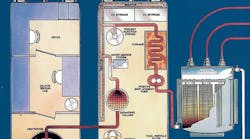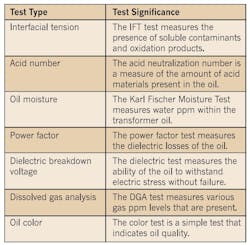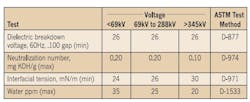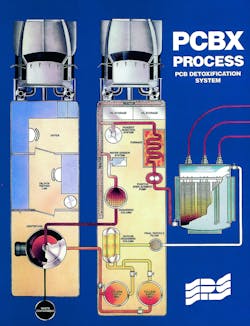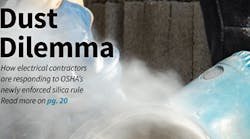The transformer's insulation is the root of the problem. Its two components, oil and cellulose paper, interact to create byproducts that decompose the insulation system. Not only that, the byproducts will increase moisture levels and create an environment that will overheat the transformer, which will eventually cause the transformer to fail.
You must first understand the problem before you can treat it. In the presence of a catalyst, such as copper, oxygen will react to form those byproducts that attack the transformer's insulation paper. Ironically, paper has an affinity for the very byproducts that contribute to its destruction, compounding the problem. In time, further reactions will create other destructive byproducts like acids, alcohols, and sludge. After saturating the paper, these byproducts will precipitate out and contaminate the oil.
Frustrating as it may be, that's just the nature of the beast. Even with the best maintenance procedures, these chemical reactions will continue to take place, and the transformer will eventually succumb to the resultant damage. However, this process can be slowed down. By treating the symptoms of the problem, you can prolong the life of the transformer. Regular oil tests will yield results that can provide a strong indication of what's occurring inside the transformer.
Testing and analysis
Substation class transformers should be subjected to a host of annual oil tests (Table 1).Just as blood tests can reveal more than one ailment, oil tests can uncover several potential problems within a transformer. The same sample can contain evidence of soluble contaminants, dielectric contaminants, and acid materials present in the oil. With so much riding on transformer maintenance, it's important to conduct and complete all of the recommended tests.
Dissolved gas analysis (DGA) and the information it can provide are particularly important in analyzing the health of the transformer and determining whether oil treatment is necessary. The rate of insulation decomposition will increase significantly in the presence of faults. By drawing a sample and having the gas composition analyzed, it's possible to distinguish between different fault types. The IEEE Guide for the Interpretation of Gases Generated in Oil-Immersed Transformers recommends thresholds for gas concentration levels (Table 2).Although transformer oil testing is important, the results will be worthless if you don't know how to interpret them. The IEEE Guide for the Reclamation of Insulating Oil and Criteria for Its Use has four classifications for oil evaluation. Table 3 lists the recommended threshold levels to deem oil satisfactory for continued service. Oil that doesn't meet the recommended levels should be reconditioned, reclaimed, or disposed of, depending on the test results.
Hot oil reclamation
The purpose of hot oil reclamation is to prolong the life of the transformer. The process removes water from the oil and the windings; acids, alcohols, dissolved gases, oxides, and other decaying byproduct contaminants from the oil; and sludge layered within the coil/core assembly and the radiators.
On-site transformer oil treatment is possible using a hot oil reclamation processing (HORP) rig, which connects to the energized transformer with two sets of high-pressure hoses (Fig. 1).The system circulates the hot oil in a closed-loop path. The reclamation process can be broken down into six components: heat, centrifuge, fuller's earth, vacuum degassing/dehydration, inhibitor, and filter stages.
Heat
The first step is to heat the oil when it enters the HORP rig. This process will help remove water adsorbed in the paper insulation and dissolve the sludge into a soluble form. It's advantageous to perform the reclamation process on an energized transformer. The heat generated by the load will aid in transferring the moisture from the paper to the oil and dissolving the sludge buildup internal to the core and coil assembly. The mechanical vibration at 60 Hz also aids in the circulation of the oil to help remove the sludge within the windings.
Centrifuge
A centrifuge isn't always necessary, but it can aid in the reclamation process by removing excess moisture and extracting insoluble contaminants like water and carbon. A centrifuge can dramatically decrease processing time and save a customer money.
Fuller's earth
Fuller's earth is a claylike substance used for filtering that adsorbs water, acids, and other oil-decaying products. As the oil passes through the fuller's earth, the adsorption process will remove the dissolved acid, sludge, and water. The continuous circulation of hot, dry, clean oil through the energized transformer will also clean the transformer as it continues to dissolve sludge, oil-decaying products, and moisture from the insulation.
Vacuum degassing-dehydration
Before the oil returns to the transformer, you need to pass it through a vacuum degassing/dehydration column to remove moisture, oxygen, and other gases. It's important to continuously operate the dehydration column so that “wet” oil doesn't return to the top of the transformer.
Inhibitor
Transformer oil often includes an inhibitor additive, which aids in the resistance of oxidation. The reclamation process can remove inhibitor, so during the last pass it's important to add it back as the oil leaves the HORP rig and returns to the transformer.
Filter stages
Metallic particles can cause serious damage like transformer failure, so it's critical to include multiple filter houses throughout the HORP rig to prevent particles from re-entering the transformer. During the last step before exiting the HORP rig, the oil passes through a .5-micron particle filter to trap any remaining particles before entering the transformer.
Retrofilling
When hot-oil reclamation isn't feasible, retrofilling can substitute for the oil treatment process. In fact, in some cases, retrofilling is the preferred option. This alternative involves draining and disposing of the oil, flushing the transformer, and then refilling it with replacement oil.
Small transformers and those without valves are good candidates for retrofilling. Oftentimes oil that has degraded severely should also be retrofilled. The disadvantage of the retrofill process is that it only reaches 10% of the interior surface of the windings, so it can't remove or clean the sludge deposits located deep within the transformer. Within a year, the transformer oil can deteriorate to the previous poor condition.
As with all other electrical equipment, substation transformers must be tested on a regular basis. Proactive maintenance can prolong the life of the transformer and delay the replacement of the unit. When the need arises to treat the oil, it's important to understand the two treatment options available and how the processes work to treat the symptoms of the problem.
Reed is vice president of Environmental Protection Services in Wheeling, W.V.
